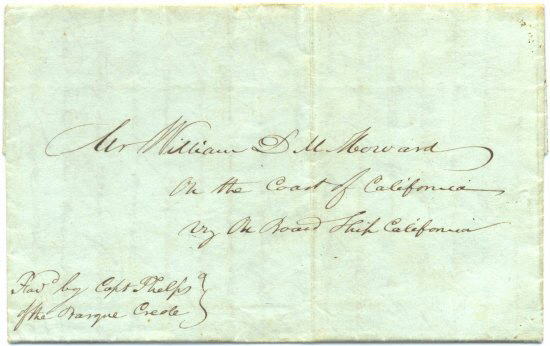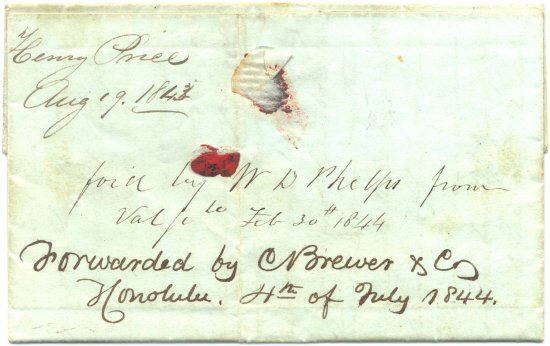::: PRE-POSTAL MAIL :::
|

|
Folded letter Dated October 22, 1825 at Honolulu and sent to Bristol, Rhode Island, via Cape Horn aboard the
ship Rob Roy. This letter was delivered to the United States Post Office at Boston where it was postmarked April 20,
1826 and rated 12¢ to be collected from the recipient upon delivery in Bristol, Rhode Island. The rate included a
2¢ ship fee plus the 10¢ United States postage rate for letters carried under 80 miles but more than 30 miles. The
notation "Favd' by Capt. Blanchard refers to the ship captain who agreed to handle the letter.
From the time of Cook's discovery of Hawaii in 1778 to November 2, 1850, handling mail in Hawaii was strictly a
private affair, with no government support or facility involved. Residents of the islands wanting to send or receive
mail from abroad were required to keep abreast of the comings and goings of vessels or use the services of a private
forwarder or handler who did stay informed. Hawaii had no postal markings and usually the only clue to the Hawaiian
origin of a letter is in its content. Envelopes came into vogue in the North Pacific only in the last couple of
years of this Period so most letters were folded inward and sealed so the address could be written on the blank
outer side.
The earliest non-petroglyph writings and letters made in Hawaii come from the first European encounter, later
explorations, an early European settler and an early trader:
- Captain Cook and several officers and crewmen on his two ships kept journals and entered notes while in
Hawaiian waters. Following Cook's death at the islands in 1779, the ships reached St. Peter and Paul on the
Kamschatka Peninsula where these journals were collected and sent overland across Siberia by a Russian military
courier. From Moscow, the journals were forwarded to London.
- In the 1790's official dispatches were sent from Capt. Vancouver by his supply ship Daedalus when she returned
to London and some of those letters might have originated in Hawaii.
- At least two "royal" letters were sent by Kamehameha I to King George in 1810.
- A Spanish resident of Honolulu, Don Francisco de Paula Marin, corresponded with friends and acquaintances on the
Spanish Coast of California, usually writing on behalf of sea captains wanting access to ports for trading along the
coast. The earliest recorded letter of his was written in 1803.
- In 1817, James Hunnewell stayed at Honolulu to sell off the cargo of a ship and sent a letter to Maine via
Canton, the Indian Ocean and Cape of Good Hope aboard the ship Alert.
All of these journals and letters were handled from sender to recipient without touching an organized postal system.
New England Protestant Missionaries began arriving at Hawaii in 1820. The earliest letter of Hawaiian origin indisputably put into an official postal system was the earliest Missionary
letter, dated May 13, 1820 and ultimately placed into the United States postal system at New York after reaching
there via Cape Horn. As it turned out, letters dated a little later than the earliest cover actually beat that cover
to United States shores and were first to enter the postal system.
Dating covers in the Pre-Postal Period usually poses little trouble since the contents of folded letters almost
always were dated somewhere. If someone used an outer letter sheet to enclose the contents and the contents are no
longer to be found with the outer letter sheet, dates will usually be seen in "docketing notes" often written on a
cover by the recipient to record the date of the letter, the date of receipt and the date of response. Painstaking
research has yielded a list of dates vessels arrived and departed Honolulu (more reliable from 1836 onward, with the
exception of 1842, than earlier) so if vessel references can be found in the contents, a letter sometimes can be
dated even without other evidence.
Letters from Hawaii to the United States or Europe typically will show postal markings applied by the post office
where the letter entered the United States or other postal system. Thus, if a ship touched London, New York, Boston
or some other port with a post office, postal clerks in those cities would rate the letter and postmark it. Hawaii
markings, if any, were those of a local forwarder. (For illustrations of Hawaiian forwarder marks used in this
Period, see Auxiliary Marks - Hawaiian Forwarder Agents)
On letters sent to the United States, the ship captain was entitled to receive a 2¢ ship fee per letter upon
delivery to a United States post office. How much, if anything, sea captains received for carrying mail to other
places is uncertain. Some letters show evidence of prepayment of certain transit fees, probably arranged by a
forwarder. Postage of the destination country was always collected upon delivery to the recipient and in the United
States the ship fee was added to the amount collected.
Letters sent to Hawaii often were handled privately throughout by employing forwarders or by making arrangements
directly with a ship captain. Some captains would carry post office mail as a courtesy to the residents of Hawaii in
order to win a favorable reputation in the islands. Other captains probably charged some fee.
Transit arrangements for mail into or out of the North Pacific could be complex, as shown in the following letter
going from New England to Alta California via Valparaiso and Honolulu.
|
|
Front of cover showing the instructions designating the ship to carry the letter.
|

|
|
|
Back of cover showing forwarding notations:
|

|
|
August 19, 1843 letter from Henry Pierce of Boston to William Howard on board the ship California, trading on the
Coast of California. Sent via Cape Horn to Valparaiso on the ship Creole, Capt. W. D. Phelps. Capt. Phelps forwarded
it, adding the manuscript "fwd by W. D. Phelps from Valpo Feb. 30th 1844" (an interesting calendar) on the back.
From Valparaiso, the letter went by an unknown ship to Honolulu where it was handled by the firm of C. Brewer & Co.,
adding the manuscript "Forwarded by C. Brewer & Co., Honolulu. 4th of July 1844." Finally, the letter was carried
from Honolulu to Monterey by the USS Levant, probably arriving in early August, 1844, a one year transit. When this
letter was delivered in Monterey, it was held by a merchant, probably Thomas O. Larkin, the U.S. Consul at that port,
for delivery to Howard when the California touched at Monterey. In 1844, Monterey was the capital of Alta California,
then a "department" of Mexico.
Shipping in the Nineteenth Century had its hazards. Duplicates often were sent for letters with commercial
importance. Loss of mail could happen with misdirection and other acts of carelessness. Shipwrecks also took their
toll. The next image is of a shipwrecked cover that survived:
|
|
|
Datelined December 16, 1847, at Honolulu by G. B. Post and written to his friend, B. L. Cutler of Woburn, Mass. Post
became a well known San Francisco merchant in the early 1850's and his forwarder mark on mail to or from Hawaii is
well known in the Early Treaty Period. (For illustration of Post's mark, see San Francisco Auxiliary Marks.) Post
had come down from San Francisco to Honolulu in the ship Maria Helena. He wrote this letter to Cutler and sent it by
the Maria Helena when she departed on December 20, 1847, for New Bedford via Tahiti and Valparaiso. En route to
Tahiti, the Captain repeated the mistake other captains made and attempted to pass Christmas Island on the lee side.
He lost wind and the current carried the ship onto the rocks. Christmas Island, near the Equator, was uninhabited,
with little potable water and only turtles and birds to catch and eat. The ship's water barrels, longboat, food and
the mail were gotten off the ship before she broke apart. The situation was desperate so the longboat was outfitted
for an attempt to return to Honolulu and a few of the crew set off for help. The 2,000 mile open sea voyage
succeeded and ships from Honolulu rescued the passengers and remaining crew and return them along with the mail.
This letter was among those saved. It bears the following note: "The Ship Helen Maria was wrecked on the passage
from Oahu to Sth America, which accounts for the appearance of this paper as having been wett." Eventually, the
letter reached New York, where it was postmarked on October 19, 1848 and rated 7cts. for the applicable U. S. zone
rate at the time (see below).
END OF THE PRE-POSTAL PERIOD
The Postal Period began officially on December 21, 1850 when the Honolulu post office opened for business. Several weeks earlier, on November 2, 1850, The Polynesian, Honolulu's weekly newspaper, announced it was keeping a letter bag open to receive letters and promised to place on board reliable vessels any letters deposited in its letter bag. The Polynesian was owned by the Hawaiian government and the letter bag it kept was a precursor of the Honolulu post office. By 1850, almost all mail was being sent to and from Hawaii via San Francisco to enter the mail stream there and be carried in the United States mail via Panama to New York.
|

STUDIES OF SPECIFIC ROUTES:
 The Indian Ocean and Cape of Good Hope Route
The Indian Ocean and Cape of Good Hope Route
 The Cape Horn Route
The Cape Horn Route
 The Mexico Route
The Mexico Route
 The Panama Direct Route before 1849
The Panama Direct Route before 1849
 Mail Via San Francisco and Panama
Mail Via San Francisco and Panama
 Mail Between Hawaii, California and Oregon
Mail Between Hawaii, California and Oregon

|
 A Summary of Rates Applicable to Mail to the United States
A Summary of Rates Applicable to Mail to the United States
|
 Census of Letters to or from Hawaii Before 1830
Census of Letters to or from Hawaii Before 1830

|
|
PRE-POSTAL BIBLIOGRAPHY
- Gast, Ross H., Don Francisco de Paula Marin, letters and journals edited by Agnes C. Conrad, The University
Press of Hawaii and The Hawaiian Historical Society, Honolulu, 1973. Honolulu letters from Marin to early
California settlers and sea captains throughout the Pacific Basin.
- Morison, Samuel Eliot, "Boston Traders in the Hawaiian Islands", Proceedings of the Massachusetts Historical
Society, p. 9-47, October-November, 1920; reprinted as Chapter III, p. 66-98, in By Land and By Sea, Alfred A.
Knopf, New York, 1928, Book Club Edition, 1954. Contains much useful information on the mercantile development
of Hawaii and the early years of the major trading houses; quotes several letters from the 1820's.
- Anonymous, "Hawaii's First Ship's Mail From The Missionaries", p. 17-22, Annual Report, 1951, Hawaiian
Historical Society, Honolulu, 1951. This article is the best written on 1820 Missionary letters; excellent
analysis; Bingham letter of May 13, 1820; quotes Bingham letter and Loomis letter in entirety.
|
|

|
|
Copyright © 1999 - 2013 POST OFFICE IN PARADISE. All rights reserved.
|
|